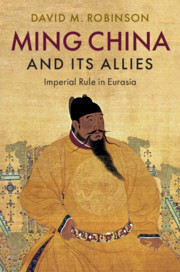Book contents
- Ming China and Its Allies
- Ming China and Its Allies
- Copyright page
- Dedication
- Contents
- Maps
- Acknowledgments
- Abbreviations
- Introduction
- 1 March to Power in a Chinggisid World
- 2 Search for Control
- 3 Mongol Nobles at the Ming Court
- 4 The Struggle for the Chinggisid Legacy
- 5 Allies and Commensurability
- Conclusion
- Bibliography
- Index
4 - The Struggle for the Chinggisid Legacy
Published online by Cambridge University Press: 10 December 2019
- Ming China and Its Allies
- Ming China and Its Allies
- Copyright page
- Dedication
- Contents
- Maps
- Acknowledgments
- Abbreviations
- Introduction
- 1 March to Power in a Chinggisid World
- 2 Search for Control
- 3 Mongol Nobles at the Ming Court
- 4 The Struggle for the Chinggisid Legacy
- 5 Allies and Commensurability
- Conclusion
- Bibliography
- Index
Summary
Using the unusually rich historical sources generated by the Tumu crisis, Chapter Four offers a reconstruction of Ming rulership in east Eurasia in the mid-fifteenth century. Chapter Four demonstrated that the fifteenth century’s first half saw a multigenerational, multifaceted competition among Mongol, Oirat, and Ming ruling elites to turn the Chinggisid legacy to their advantage. Each developed a genealogy or pedigree of rulership, which it advertised to its neighbors. The best-documented example, that of the Ming dynastic house, trumpeted the superior attributes of the rulership of Zhu Yuanzhang and his descendants. Just as emphatically, the Ming throne denied the qualifications of rival lords such as Toqto’a-Buqa and Esen. The Ming ruling family and its close supporters tried to persuade several audiences, including Jurchen chieftains, the Choson throne, and Oirat and Mongol leaders, of its historical vision of the past and the present.
Keywords
- Type
- Chapter
- Information
- Ming China and its AlliesImperial Rule in Eurasia, pp. 131 - 162Publisher: Cambridge University PressPrint publication year: 2020

